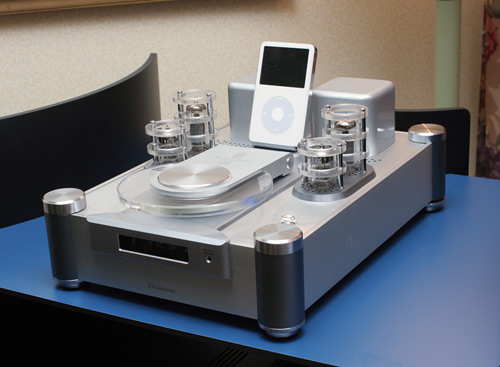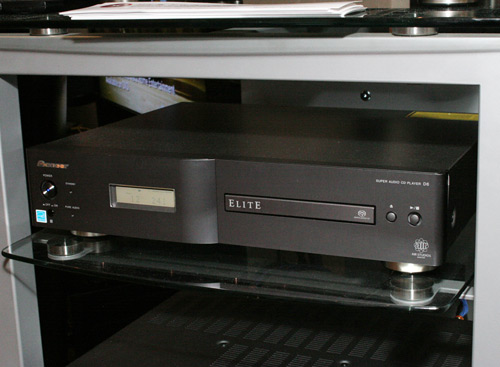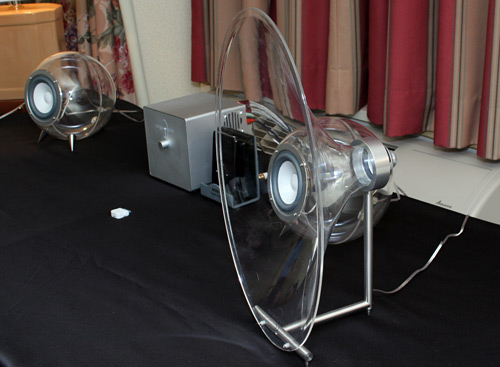Festival Son & Image 2007
When, in April, I visited the Festival Son
& Image, held at the Sheraton Centre hotel in Montreal, Canada, my job was to seek out
anything new and interesting in the world of affordable sound. But this was the first
audio show I’d ever attended, and I wasn’t sure what to expect. My SoundStage!
Network press badge not only let me bypass the long line of consumers waiting to get in, I
also enjoyed some of the best treatment I’ve ever received from audio dealers.
During my time at FS&I I heard many things that sounded
promising, but I quickly learned that serious listening is next to impossible at such an
event. There are too many people moving about and talking for any kind of careful
listening. However, despite the limited space, unreliable power supply, and high
background noise, I thought most exhibitors did a pretty good job of setting up their
systems. Here’s what I saw and heard. Unless otherwise noted, all prices are in
Canadian dollars.
The wonderful world of tubes
One of my first stops was Charisma Audio, the Canadian
distributor for Shanling. Founded in 1988, Shanling is a growing manufacturer of
electronics designed and built in China, and the first of their components to catch my
attention in Montreal was the MC-3 music center: a single chassis comprising a tube
integrated amplifier (3.5Wpc), CD player, AM/FM tuner, and iPod dock. It has just one
input and one output, and the CD player and preamp can be used independently. Can you say
"convenient"? To describe its appearance as "stunning" wouldn’t
quite do it justice -- this is the sort of piece you’d want to own just to show off
to visitors who never realized such things existed. But what most impressed me was its
price: $1099. Had I been told the MC-3 cost twice that, I wouldn’t have been
surprised.

Shanling's MC-3 music center.
In the room of Calgary retailer Loyalty Sound I found two
affordable tube-based integrated amplifiers, also made in China. One, the fine-looking,
Cayin A-60T, retails for $1300; the other, the 38Wpc Melody SP3, costs $1550 -- its sharp
appearance and build quality made its price seem quite reasonable. The SP3 wasn’t
being used when I visited, but feeding the A-60T was Melody’s CD-M10 CD player
($4400), which features Burr-Brown PCM1792 DACs and weighs a ridiculously heavy 75 pounds.
At the end of the chain was a pair of Silverline Audio Preludes ($1500/pair): a two-way,
floorstanding, bass-reflex speaker with two 3.5" aluminum/magnesium-alloy mid-woofers
in a midrange-tweeter-midrange (MTM) configuration with a single tweeter. The Prelude
measures 40"H by a mere 5"W x 8"D, but this setup made one of the biggest
impressions on me at FS&I -- the sound radiating from these incredibly slim speakers
was surprisingly full. Obviously, the rich, warm sound was the result of the tubes used
throughout, but I still had a hard time believing that just four tiny mid-woofers could
fill in the low end so well. In a small to mid-sized room, this little system could
provide all the bass I’d ever need.
I was fairly preoccupied with all of the affordable tube
amplifiers I encountered in Montreal. I’ve never owned tubes, but if I ever decide to
try them in a second system, the Shanling, Cayin, and Melody models all made very good
impressions; one of them seems as good a starting point as any.
One more brand to add to the list is Omaha Audio,
inexplicably based in Walnut, California. Omaha made their debut only four months ago, at
the 2007 Consumer Electronics Show, and so are still a lesser-known quantity in hi-fi
circles. After visiting their room and seeing their product line, I don’t imagine
this situation will last long. One of Omaha’s smartest-looking pieces was their sleek
OD-300B, a single-ended-triode (SET) integrated amplifier that employs a pair of 300B
vacuum tubes to produce 10Wpc ($1575). If more power is needed, there’s the OD-EL34B
tube integrated amp, which boasts 35Wpc ($1125). The OD-EL34B should provide more
flexibility in choosing speakers than the low-powered SET model.

Omaha Audio's OD-EL34B integrated amp.
Back to solid-state
Back in the land of transistors, I found, at the Tangent
and Pioneer Elite displays, what seemed to be two of the biggest bargains of FS&I.
Tangent began designing loudspeakers in Britain in 1996,
and since then has expanded their product line to include a complete suite of electronics.
Tangent is owned by Danish company Eltax; all design and engineering is done in Denmark,
and the products are manufactured in China.
Three things about Tangent attracted me. First was the fact
that their electronics bore a resemblance to those of Cambridge Audio -- not a bad company
to emulate, especially if you’re concerned about integrating electronic gear with
contemporary décor. Second were the compact and, in some cases, wildly colorful cabinets
of Tangent’s EVO loudspeakers. Not only did these small speakers feel pretty solid,
you should be able to find something you like among the choice of five high-gloss
finishes. Third were the prices.
Tangent’s 50 series of electronics comprises the
AMP-50 integrated amplifier and the CDP-50 CD player, each of which retails for only $299.
The flexible AMP-50 has a moving-magnet phono stage as well as a headphone jack. For
another $259, the system can be completed by the addition of a pair of EVO speakers. That
this entire system can be had for only $857 was pretty remarkable. I hope we can arrange a
review of a complete Tangent system sometime soon.

Tangent's AMP-50 (top) and CDP-50 retail for $299
each.
Tangent also showcased a line of tabletop radios, including
the Uno ($229-$249, depending on finish), Duo ($299-$329), Trio (not on display), and
Quattro. The Uno is a basic AM/FM radio in a retro-styled box very similar in appearance
to the popular Tivoli Audio models, and can be ordered with an optional red high-gloss
finish. The Duo is basically a Uno with an alarm clock. The Trio adds to these a DAB tuner
and a brightly backlit display, making for a chic design. And the Quattro is a Trio with
wireless Internet radio.
My second bargain-hunting surprise was Pioneer Elite’s
new stereo receivers and SACD player. I’d assumed the Elite models would command much
higher prices, but the A9 stereo receiver, which offers 75Wpc into 6 ohms and comes in a
handsome charcoal enclosure, sells for only $1000. The smaller A6 produces 55Wpc into 6
ohms and retails for $600. But what struck me as the biggest value of the three was the D6
two-channel SACD/CD player, at $500. Not only does it cosmetically match the A9 and A6,
but its focus on two-channel SACD in an age of surround sound gave me the sense that
Pioneer has not abandoned stereo sound.

The Pioneer Elite D6 SACD player.
If you want to listen to music and watch movies without the
hassle of fine-tuning your speakers’ placements and running cables around the room,
Niro’s 620 system ($1295) might be for you. Niro Nakamichi, founder of the famous
Nakamichi company, is the man behind this system. The 620 comprises just three components,
including a digital amplifier-processor, an 8" passive subwoofer, and a single
speaker enclosure containing five separate wideband drivers. Three of these drivers
produce the left-to-right front image, while the other two produce the rear surround
image. To simulate the surround effect, the 620 relies less on room reflections than on
time delays, phase changes, and other special adjustments made by the processor. I watched
some footage from Pearl Harbor and was impressed with how "big" the sound
was, but I can’t say it imaged like a true surround system, at least not from my
seat. However, it sure seemed promising.
I haven’t touched on two-channel speakers too much
because many of the speakers I saw were expensive, and in some cases ridiculously
overpriced. However, not every speaker at FS&I was ultra-expensive -- as I
discovered at the Monitor Audio and Ferguson Hill demonstrations.
In addition to their new, flagship Platinum speaker,
Monitor Audio displayed their more affordable Bronze R, Silver RS, and Gold Signature
lines. I’ve taken a greater interest in Monitor since listening to the Silver RS-6
tower ($1000/pair USD), a midsized floorstander that I have in for a review that will
appear in GoodSound! in the coming months. Much like the Energy RC-70 I wrote about
for SoundStage! last fall, the Silver RS speakers come in a choice of real-wood
veneers that look more expensive than they are.
Finally, in the Ultimate Audio Video room there was a
speaker system that turned a few heads and would not have looked out of place in Stanley
Kubrick’s 2001: A Space Odyssey -- Ferguson Hill’s FH007 ($1195 USD),
described by the folks at Ultimate Audio Video as the "ULTIMATE iPod speaker
system." The FH007 is a mini-system featuring two horn and two bass drivers powered
by an integrated amplifier that puts out 16Wpc. The most striking thing about these
speakers is that their cabinets are made of clear plastic. In fact, the silver chassis of
the accompanying integrated amplifier looked drab in comparison. Also on display was the
soon-to-be-released FH008 powered subwoofer ($595 USD). Given the limited bass extension
of the FH007 on its own (-5dB at 75Hz), I’d say the FH008 is a must. While I
can’t vouch for Ultimate AV’s claim about it being the "ultimate" iPod
speaker system, the speakers did make the boldest aesthetic statement at FS&I.

Ferguson Hill's FH007 speaker system certainly turned
some heads.
Conclusion
I enjoyed my first high-end show experience. At Festival
Son & Image I saw and heard things I’d only ever read about before, and in some
cases never even knew existed. John Crossett, a fellow SoundStage! Network writer, once
told me that audio is all about choices. After attending FS&I, I now know what he
meant.
One thing that left a strong impression on me had nothing
directly to do with any of the products I saw. Rather, it was the large number of people
in attendance that drew my attention. I suppose it helped that the weather was a bit
miserable, but it was obvious from seeing all of these people that Montreal is home to a
large and enthusiastic audiophile community. The crowd’s excitement was contagious;
if Montreal is any indication, the future of audio should be in good hands, and Festival
Son & Image should continue to be a great success.
...Philip Beaudette
|